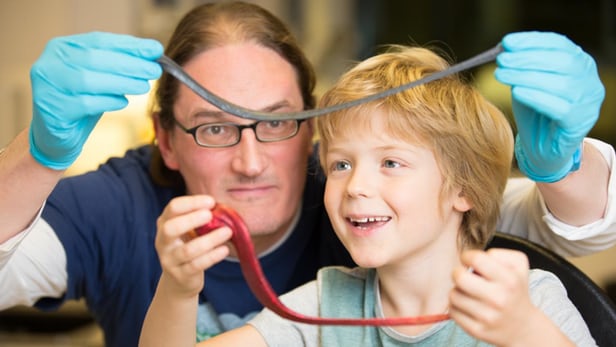近日,《Science》报道研究人员在硅胶(PDMS)中加入加入少许石墨烯材料制备的橡皮泥,其电性能对材料形变异常敏感,即使时轻微的形变或碰撞,其电阻性发生翻天覆地的变化,超级敏感性,超出传统传感器敏感性百倍以上。(加小编微信2322739585,加入石墨烯微信群)。比如,可以感应到小蜘蛛爬行的步伐、血压变化等等,有望在医疗器械等领域发挥重要作用。
推荐文献:Sensitive electromechanical sensors using viscoelastic graphene-polymer nanocomposites,Conor S. Boland1, Umar Khan1, Gavin Ryan1, Sebastian Barwich1, Romina Charifou1, Andrew Harvey1, Claudia Backes1, Zheling Li2, Mauro S. Ferreira1, Matthias E. Möbius1, Robert J. Young2, Jonathan N. Coleman1,* Science 09 Dec 2016: Vol. 354, Issue 6317, pp. 1257-1260,DOI: 10.1126/science.aag2879

Abstract
Despite its widespread use in nanocomposites, the effect of embedding graphene in highly viscoelastic polymer matrices is not well understood. We added graphene to a lightly cross-linked polysilicone, often encountered as Silly Putty, changing its electromechanical properties substantially. The resulting nanocomposites display unusual electromechanical behavior, such as postdeformation temporal relaxation of electrical resistance and nonmonotonic changes in resistivity with strain. These phenomena are associated with the mobility of the nanosheets in the low-viscosity polymer matrix. By considering both the connectivity and mobility of the nanosheets, we developed a quantitative model that completely describes the electromechanical properties. These nanocomposites are sensitive electromechanical sensors with gauge factors >500 that can measure pulse, blood pressure, and even the impact associated with the footsteps of a small spider.
解读:Researchers in AMBER, the Science Foundation Ireland-funded materials science research centre, hosted in Trinity College Dublin, have used the wonder material graphene to make the novelty children’s material silly putty® (polysilicone) conduct electricity, creating extremely sensitive sensors. This world first research, led by Professor Jonathan Coleman from TCD and in collaboration with Prof Robert Young of the University of Manchester, potentially offers exciting possibilities for applications in new, inexpensive devices and diagnostics in medicine and other sectors. The AMBER team’s findings have been published this week in the leading journal Science*.
Prof Coleman, Investigator in AMBER and Trinity’s School of Physics along with postdoctoral researcher Conor Boland, discovered that the electrical resistance of putty infused with graphene (“G-putty”) was extremely sensitive to the slightest deformation or impact. They mounted the G-putty onto the chest and neck of human subjects and used it to measure breathing, pulse and even blood pressure. It showed unprecedented sensitivity as a sensor for strain and pressure, hundreds of times more sensitive than normal sensors. The G-putty also works as a very sensitive impact sensor, able to detect the footsteps of small spiders. It is believed that this material will find applications in a range of medical devices.
Prof Coleman said, “What we are excited about is the unexpected behaviour we found when we added graphene to the polymer, a cross-linked polysilicone. This material as well known as the children’s toy silly putty. It is different from familiar materials in that it flows like a viscous liquid when deformed slowly but bounces like an elastic solid when thrown against a surface. When we added the graphene to the silly putty, it caused it to conduct electricity, but in a very unusual way. The electrical resistance of the G-putty was very sensitive to deformation with the resistance increasing sharply on even the slightest strain or impact. Unusually, the resistance slowly returned close to its original value as the putty self-healed over time.”
He continued, “While a common application has been to add graphene to plastics in order to improve the electrical, mechanical, thermal or barrier properties, the resultant composites have generally performed as expected without any great surprises. The behaviour we found with G-putty has not been found in any other composite material. This unique discovery will open up major possibilities in sensor manufacturing worldwide.”
Professor Mick Morris, Director of AMBER, said: “This exciting discovery shows that Irish research is at the leading edge of materials science worldwide. Jonathan Coleman and his team in AMBER continue to carry out world class research and this scientific breakthrough could potentially revolutionise certain aspects of healthcare.”
Prof Coleman is a partner in Graphene flagship, a €1 billion EU initiative to boost new technologies and innovation during the next 10 years.
About Graphene
Graphene consists of atomically thin layers of carbon atoms and has a range of superlative properties – the strongest and most conductive material among others.
Prof Coleman was announced as a recipient of a €2.2m European Research Council (ERC) Advanced Grant earlier this year. The prestigious ERC Advanced Grants are only made to Europe’s most distinguished researchers. Coleman’s work has been published in prestigious international journals such as Science, Nature, Nature Nanotechnology, Nature Materials and nature Communications, as well as featuring in New Scientist, the New York Times and on CNN. He was recently included by Thomas Reuters in their Highly Cited Researchers 2016 list.
上述资料来源:ambercentre.ie,仅供参考。